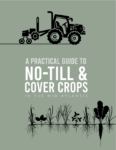The educational materials listed on this page are about Conservation Tillage.
Conservation tillage reduces soil disturbance by leaving more than thirty percent of the soil surface covered with the residue of a previous crop. This crop production system improves soil conservation, reduces soil erosion and limits water runoff. Producers can choose from several different conservation tillage systems no-till, strip-till, ridge-till or zone-till—based on their individual cropping system and on the amount of residue they want to leave on the soil surface. There is also a variety of tillage equipment available for farmers and ranchers, depending on which tillage system they use. No-till farming leaves all of the previous crop’s residue on the field. Farmers who use a strip-till system only disturb the section of soil that is necessary for seeding. Strip tillage is similar to zone tillage, but the latter cuts deeper into the soil to increase water infiltration. In ridge-till systems, farmers build raised seed beds to create a warmer seedbed with better drainage. Cover crops can be added to any conservation tillage system to provide additional residue and soil cover between cash crops.
Showing 1-3 of 3 results
How Alive is My Soil?
This guide presents soil testing methods that can be performed in the field by farmers, gardeners, or anyone who desires to understand and appreciate soil from a different perspective. While these tests aren’t intended to be a replacement for sending soil to a lab, they can be considered complementary to annual or biannual lab analysis.

Cornell Soil Health Assessment
The Cornell soil health assessment was created to help farmers develop appropriate management solutions to build healthy soils. Focusing on soil health helps improve productivity, reduces the need for external inputs, and increases a farm's resilience to extreme weather events.

A Practical Guide to No-Till and Cover Crops in the Mid-Atlantic
No-till and cover crops are among the most cost effective tools to reverse soil and carbon loss and improve soil health; the economic, agronomic and environmental benefits of these practices are well known within the farming community. Transitioning from conventional farming to no-till, and incorporating the use of cover crops, requires a higher level of […]